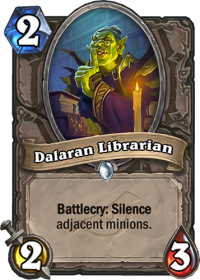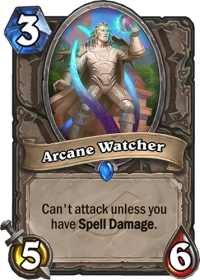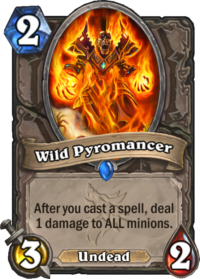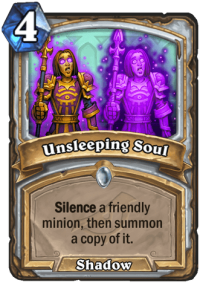Our Silence Priest deck list guide goes through the ins-and-outs of this off-meta Priest build for the Rise of Shadows expansion! This guide will teach you how to mulligan, pilot, and substitute cards for this archetype!
Introduction to Silence Priest
Like many other iconic archetypes, Rise of Shadows also brings Silence Priest back on the menu. Priest’s exclusive Silence effects have been around since Vanilla Hearthstone, and Team 5 tried to play around with different design ideas for Priest around disabling card texts and effects. We all remember the Purify debacle, which actually turned the Un’Goro Silence Priest iteration into a decent deck list, not last because of cards like Humongous Razorleaf and Kabal Songstealer.
The new expansion doubles down on a minion-heavy deck theme combined with classic Priest tools that enable card draw and massive attack values. And although Priest may be on the shorter end of total class strength in the young Standard year, there’s most definitely a place for the satisfying playstyle of Silence Priest!
Silence Priest Deck List
Check out alternative versions of this deck on our Silence Priest archetype page!
Silence Priest Mulligan Strategy & Guide
Vs Aggro Decks
The mulligan mantra against aggro decks should include two words and two words only: Wild Pyromancer. If you see Wild Pyromancer, Power Word: Shield is a safe keep as well against classes like Warlock and Druid. Northshire Cleric looks great in every opening hand, but you want to find Wild Pyromancer first and foremost.
Cards to keep: Northshire Cleric, Wild Pyromancer, Power Word: Shield, Ancient Watcher/Dalaran Librarian if you have Wild Pyromancer and Northshire Cleric
Vs Control Decks
Silence Priest wants to put big minions on the board early, so we need to find those in the mulligan as often as possible. However, depending on your starting mulligan, you can keep draw engine pieces like Northshire Cleric and Wild Pyromancer and/or Circle of Healing. That being said, it’s mostly still the best to keep looking for big guys.
Cards to keep: Northshire Cleric, Ancient Watcher, Arcane Watcher, Dalaran Librarian of you have Ancient Watcher and Arcane Watcher
Silence Priest Play Strategy
General Strategy
The universal game plan for Silence Priest always was and will be the same: Build big minions and hit a lot of face very early. The ability of Silence Priest to highroll any deck out of the game, no matter if aggro, mid range or control, is unmatched.
To make sure that we hit those highroll situations as often as possible, an aggressive mulligan is imperative, as already mentioned in the Mulligan Strategy. The more we hit our key cards early, the better.
However, we need a more reliable backup plan in case we don’t draw into these “nut hands”. One of the few things Priest excels at is drawing cards in the early and mid game. The ridiculously powerful draw engine around Northshire Cleric, Wild Pyromancer, Circle of Healing, Power Word: Shield and Acolyte of Pain ensure that Silence Priest can put up multiple waves of very problematic board states.
These board states will be established by classic Silence Priest cards like Ancient Watcher, but we also see a total of three new minions joining the fray: Arcane Watcher is Ancient Watcher‘s bigger brother; the card effect really doesn’t spark any interest, as we are only after the 11 stats for 3 mana.
If we don’t find any early Silence effects for it, we can at least copy its health value with Faceless Rager, the very first “Rager” card in Hearthstone existence that will see competitive play. Just like Twilight Drake it is very prone to Silence effects, but that is a common disadvantage that Silence Priest just has to live with.
Hench-Clan Shadequill has very powerful stats and a solid body but also detrimental card text on first sight; however, limited amounts of healing don’t really save our opponent in most situations anyway.
That is thanks to Priest’s classic “combo” package containing Inner Fire and Divine Spirit. Yes, the loss of Shadow Visions hurts Silence Priest a whole lot as it enabled you to find combo pieces much more reliable; but it is still a powerful pair of four cards that Silence Priests need to pack that one deadly punch.
Again, playing your alternative routes in the game if you don’t draw into specific cards is key with Silence Priest. If you can’t draw your combo pieces, you need to make sure to get in as much points of damage as early as possible, especially against control opponents. With the fresh Standard year, early hard board removal is scarce, and that is why you can build up lots of early and mid game board states that bring the pain.
Dalaran Librarian and Unsleeping Soul are the two new “enablers” for Silence Priest that will wake up your sleeping board threats. One of the archetype’s main weaknesses was its disability to interact with multiple friendly targets at once; the player always had to decide between multiple targets on its board side. Thanks to Dalaran Librarian‘s adjacent mechanic you can enable two minions at once which makes early game damage a lot more reliable, and Unsleeping Soul produces – besides silencing the target minion – additional value for a decent cost.
Witchwood Grizzly is the special guest in this iteration of Silence Priest. Taunt minions are great in the current meta against aggro lists that don’t run Silence effects, and thanks to the incredibly high health value once silenced, it can become a perfect target for an early combo with only one copy of Divine Spirit in hand.
Vs Aggro Decks
Like many other iterations of Priest decks in recent time, Silence Priest has decent matchups against most aggro decks in the current meta game. The main reason behind that is Wild Pyromancer, a card that works exceptionally well against decks like Token Druid and Zoo Warlock. The common concept behind clearing the board with the 2-cost minion and cheap spells has always worked like a charm, and most Priest players are experienced enough to know how and when to use that powerful combination of cards, which shows a clear advantage of playing Silence Priest.
The matchup against Rogue, the strongest class in the current meta, plays out quite favorable as well. Cards like EVIL Miscreant are tough to kill for most classes, but the ability to deal huge chunks of minion damage early makes Silence Priest very resilient against cheap high-health threats like Dread Corsair or Hench-Clan Thug. Besides that, one of the most challenging early game threats that Rogue has to offer, Edwin VanCleef, is easy to handle thanks to Silence.
Midrange Hunter really comes down to early board advantage. Similar to Tempo Rogue, you can deal with the main threat called Scavenging Hyena thanks to Silence pretty easily at any given moment in the game; however, carads like Kill Command and Dire Frenzy are great tools to deal with early minion pressure by Silence Priest.
Vs Control Decks
The playstyle against control decks looks a lot more complex compared to aggro opponents. As said before, it is key to manage your resources. If you draw into early minions and enabler cards, you have to calculate the risk of overextending against possible board clears.
Control as well as Bomb Warrior have plenty of ways to remove threats early, so this matchup doesn’t look very favorable on first sight. Because of that it is of paramount importance that you try to bait out removal as early as possible, so that you can establish multiple waves of threats on the board. However, that can only happen if you draw enough cards during the early and mid game, and that is where the problems come in: You can only play so many cards during those stages of the game.
Matchups against other control archetypes look much better: The general win rate against Conjurer Mage for example looks solid, just because Silence Priest can put big minions on the board earlier, and that basically decides every single match.
Silence Priest Tech Cards and Card Substitutions
- Sunfury Protector: On first thought, this card could be a perfect inclusion, especially against aggro opponents. However, this list should have plenty of ways to enable our minions. Witchwood Grizzly can provide a decent amount of Taunt value as well, and Wild Pyromancer should be enough fuel to light up the board several times.
- Forbidden Words: This new Rise of Shadows spell provides excellent hard removal, and can work wonders against early threats like EVIL Miscreant.
- Divine Hymn: This spell can be used as another activator for Wild Pyromancer and helps drawing cards in the early and mid game. You can include this card if you want to run a more combo-centric list
- Convincing Infiltrator: This minion looks decent on paper, but its mana cost and general utility just doesn’t fit the theme of Silence Priest quite right.
Leave a Reply
You must be logged in to post a comment.



















There is no win condition is this version of silence priest!
Since the beg of Rise of Shadows silent priest is my only priest deck and i play a lot of it with some success thats why i will share with you what i’ve discovered. This deck is highly hand dependable if you dont have good starting hand there is no hope for you…
thats why i like acolyte of pain here even tho i play without it.
Archmage Vargoth is core combo card in version of silence priest that im playing with mind blast you can do 10 dmg to enemy face for 6 mana if you can pull it then you probly won already. Silence priest is a tempo oriented deck so in my opinion it is a must have!
I thought Leeroy will be great couse you can unsleeping soul him and make 12 dmg but it does not work that way 😛 if you silence Leeroy he wont have charge so its hopeless play but he can be great finisher either way. I dont like grizzlys here. Who want to defend himself with tempo deck? You go face thats the point of it and if something is blocking your path u silence it or finishing your oponent with mindblast without that in mind you will lose almost every matchup on current ladder.
This is the deck i play! And its fine its not perfect like i said but its fun! Always keep northsire cleric and you’ll be fine 🙂
AAECAa0GAq8E1pkDDu0BoQTdBOUE9gelCdIK8gzl9wKDlAOHlQOumwOCnQPInQMA
i copy some shit by mistake here’s the link
https://www.hearthstonetopdecks.com/decks/silence-priest-rise-of-shadows-legend-emem/
Thanks for the Forbidden Words – Mountain Giant comments, I was just testing y’all! 🙂
Corrected Mountain Giant to EVIL Miscreant, the card I originally wanted to have in there, and that is much easier to remove by Forbidden Words!
“Forbidden Words: This new Rise of Shadows spell provides excellent hard removal, and can work wonders against early threats like Mountain Giant.” I’m sure 8mana remove one minion is early game!
Sorry for the roast overall great guide tho
I got destroyed by silence priest a few times at about Rank 5-4. If this deck curves out well, than you are really in trouble.
Great guide, I might give this deck a try!
One thing looked really bizarre to me, though: How exactly is spending 8 mana on Forbidden Words a great counter to an early Mountain Giant?
Could you go into a little more detail into how exactly you handle Rogue’s early game? Like: do you drop the Wild Pyro on curve for later usage and just hope they don’t have Backstab, Deckhand or Deadly Poison? Or do you save it until you can combo it same-turn, and if so, which turn? It won’t kill a Miscreant, and unless you get extremely lucky it seems like you won’t be able to kill Corsairs same-turn either… I’m just not understanding how this is “quite favorable”.
Pyromancer serves as a catchup card in the matchup, I’d almost never play it on curve.
The minions that kill Miscreant are our other minions like Ancient Watcher or Arcane Watcher. They help us to survive turn 3 and 4, and although we can’t do anything against nutty Shadowstep hands, there is a high chance that insane Raiding Party plays will still leave something on our side of the board that we can buff up in the process.
It says token druid list at the beginning.
Great article btw, love this archetype
Sorry, we just copied a template and forgot to change that one part. Fixed now, thanks 🙂